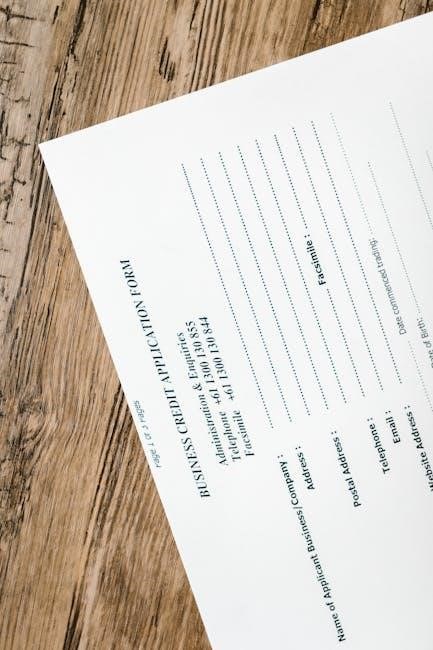Form 1139 Instructions: A Comprehensive Guide
Navigating IRS forms can be daunting. This guide provides a comprehensive overview of Form 1139, designed to help corporations understand its purpose, eligibility, and filing requirements. Stay informed and ensure accurate submissions!
What is Form 1139?
Form 1139, titled “Corporation Application for Tentative Refund,” is an IRS form used by corporations (excluding S corporations) to apply for a quick refund of taxes. This refund stems from the carryback of certain losses or credits to prior tax years. Specifically, it addresses situations involving a net operating loss (NOL), a net capital loss, or an unused business credit. The form allows corporations to recover previously paid taxes when they experience a financial downturn that results in losses or unused credits that can offset prior year’s income. Filing Form 1139 offers a faster refund process compared to filing an amended return (Form 1120X), providing quicker access to needed funds. It’s crucial for corporations experiencing losses or unused credits to understand and utilize Form 1139 to potentially recoup taxes paid in prior profitable years, therefore improving cash flow during challenging periods.

Purpose of Form 1139
Form 1139 allows corporations to claim a quick refund by carrying back a net operating loss, net capital loss, or unused credit. It provides faster access to funds compared to filing an amended return.
Quick Refund Application
Form 1139 serves as a corporation’s application for a tentative refund. This quick refund is primarily sought when a corporation experiences a net operating loss (NOL), a net capital loss, or has unused business credits. Instead of waiting for the standard amended return process, Form 1139 allows for a faster refund.
The application must demonstrate how these losses or credits impact prior year’s tax liabilities. By carrying back these items, the corporation can recoup previously paid taxes. This provides immediate financial relief, improving cash flow. Remember, accuracy is key when completing the form to ensure a smooth and expedited refund process.
Eligibility hinges on strict adherence to IRS guidelines and filing deadlines.
Carryback of Losses and Credits
The primary function of Form 1139 revolves around the carryback of net operating losses (NOLs), net capital losses, and unused credits. Corporations experiencing these financial setbacks can utilize this form to claim refunds from prior tax years. This mechanism allows businesses to recover taxes paid in profitable years, offsetting current losses.

The process involves recomputing the tax liability for the carryback year, factoring in the NOL, capital loss, or credit. The reduction in tax owed for the prior year results in a refund. Specific rules govern the carryback period, which dictates how many years prior the loss or credit can be applied; Understanding these rules is vital for maximizing the potential refund.
Careful calculation and documentation are essential for a successful carryback claim.

Who Should File Form 1139?
Form 1139 is primarily for corporations seeking a quick refund. They typically experienced a net operating loss, net capital loss, or unused business credit, which they want to carry back.
Corporations (Excluding S Corporations)
Generally, C corporations, as opposed to S corporations, are eligible to file Form 1139. This application is for a tentative refund due to a carryback. This carryback could stem from a net operating loss (NOL), a net capital loss, or an unused business credit. S corporations typically handle losses and credits differently, passing them through to their shareholders. Therefore, they generally do not file Form 1139.
It’s important to accurately determine your corporation’s status before filing. Incorrectly filing could lead to processing delays or even rejection of the refund claim. Consult IRS regulations or a tax professional if you’re unsure about your corporation’s eligibility; Make sure you understand the specific rules that apply to C corporations versus S corporations to ensure compliance and maximize potential tax benefits related to loss or credit carrybacks. Proper identification is key.

When to File Form 1139
Timing is crucial. Generally, corporations must file Form 1139 within 12 months from the end of the tax year in which the loss or credit occurred, prompting the carryback claim.
Filing Deadline: 12 Months
The most critical aspect of filing Form 1139 is adhering to the strict 12-month deadline. This timeframe begins at the close of the tax year in which the net operating loss (NOL), net capital loss, unused credit, or claim of right adjustment arises. Missing this deadline will result in the rejection of your quick refund application, potentially delaying the receipt of funds.
To ensure compliance, mark your calendar with the filing deadline. Gather all necessary documentation well in advance. Double-check all information for accuracy before submitting the form. Consider seeking professional tax advice to navigate complex situations and avoid costly errors. Accurate timing and diligent preparation are crucial for successfully claiming a tentative refund.
Remember that this deadline applies to most situations. Always consult the latest IRS guidelines or a tax professional for specific circumstances.
End of Tax Year Considerations
As the tax year concludes, corporations should proactively assess their financial standing to determine eligibility for Form 1139. Review income and expenses carefully to identify potential net operating losses (NOLs), net capital losses, or unused credits that could qualify for a carryback and a quick refund.
Accurate record-keeping is paramount during this assessment. Ensure all financial transactions are properly documented and categorized. Consult with accounting professionals to analyze potential loss carryback opportunities. They can provide expert guidance on optimizing tax strategies.
Furthermore, be mindful of any legislative changes that might impact the carryback rules. Tax laws can evolve, so staying informed is essential. Proactive planning during the year-end can streamline the Form 1139 filing process. This ensures compliance, and maximizes the potential for a timely refund. Don’t delay assessing your position until the filing deadline looms. Start early!

Where to File Form 1139
Form 1139 should be filed with the IRS Service Center where the corporation typically files its income tax return. Do not include it with the income tax return itself.
IRS Service Center Location
To determine the appropriate IRS Service Center for filing Form 1139, corporations should refer to the instructions for their regular income tax return. The designated service center is typically based on the corporation’s location or the type of return being filed.
It is crucial to verify the correct address to ensure timely processing of the refund claim. Mailing the form to the wrong location can result in delays or even rejection of the application. Consult the most recent IRS publications or the IRS website for updated information on service center locations.
Remember, accuracy in filing is paramount. Double-check the address before mailing Form 1139 to avoid unnecessary complications and to expedite the refund process.
Filing Form 1139 to the correct location ensures that the application is processed promptly and efficiently, ultimately leading to a faster refund.
Filing with Income Tax Return
It’s important to note that Form 1139, the Corporation Application for Tentative Refund, should not be filed along with the corporation’s regular income tax return. These are separate filings with distinct purposes and timelines. The IRS instructions explicitly state that Form 1139 must be mailed to the designated service center independently.
Attempting to include Form 1139 with the income tax return may cause processing delays or even rejection of the refund application. The IRS processes these forms through different channels, and combining them can disrupt the established workflow.
Therefore, always ensure that Form 1139 is prepared and mailed separately to the appropriate IRS Service Center, as indicated in the form’s instructions. This ensures efficient processing and avoids potential complications in receiving the refund.
Remember, separate filing is key to a smooth and timely refund process.

Key Sections of Form 1139
Form 1139 has key sections that detail loss and credit carrybacks. These sections involve net operating loss (NOL), net capital loss, and unused credit carrybacks, each requiring specific calculations and supporting documentation for accurate filing.
Net Operating Loss (NOL) Carryback
The Net Operating Loss (NOL) carryback is a crucial provision that allows corporations to recover taxes paid in previous years when they experience a loss in the current tax year. This mechanism is designed to provide immediate financial relief. Form 1139 facilitates the application for a quick refund based on the carryback of the NOL.
To accurately complete the NOL carryback section, corporations must carefully calculate the amount of the NOL available for carryback. The process involves adjusting taxable income to determine the allowable loss. The carryback period is generally defined by current tax law, and understanding these rules is essential.
This section requires entering detailed income and loss information for the relevant years. Proper documentation, including prior year tax returns and supporting schedules, is necessary to substantiate the claim. Furthermore, corporations should be aware of any limitations or special rules that may apply to their specific situation, ensuring compliance and maximizing potential refunds.
Net Capital Loss Carryback
The net capital loss carryback provision within Form 1139 allows corporations to recoup taxes paid in prior years due to capital losses incurred in the current year. This is particularly relevant for businesses that experience significant losses from the sale or exchange of capital assets.
When completing this section, corporations must accurately determine the amount of the net capital loss available for carryback. This involves calculating the difference between capital gains and capital losses, considering any limitations imposed by the IRS. Like NOL, the carryback period for net capital losses is subject to specific rules, requiring careful attention to detail.
Corporations must provide detailed information about their capital gains and losses for the relevant years. Supporting documentation, such as sales records and brokerage statements, is crucial for substantiating the claim. Furthermore, understanding the interaction between net capital losses and other tax attributes is essential for maximizing the benefits of the carryback provision and ensuring compliance with all applicable regulations.
Unused Credit Carryback
The unused credit carryback feature of Form 1139 is valuable for corporations that have earned certain tax credits but were unable to fully utilize them in the year they were generated. This mechanism allows businesses to carry back these unused credits to prior tax years, potentially resulting in a refund of previously paid taxes;
To claim an unused credit carryback, corporations must identify the specific credit involved and determine the amount of the unused credit available. This requires careful review of the credit’s eligibility requirements and any limitations on its use. The carryback period for each credit varies depending on the specific credit and applicable tax law.
Detailed calculations and supporting documentation are necessary to substantiate the claim. This includes forms and schedules related to the specific credit, as well as information demonstrating that the credit was properly earned and that it remains unused. Understanding the nuances of each credit and its carryback rules is crucial for accurate completion of this section of Form 1139.

Completing Form 1139: Step-by-Step
Filing Form 1139 involves several key steps. This section offers a detailed, step-by-step guide to ensure accurate completion. Follow these instructions carefully to navigate each section and maximize your potential refund efficiently.
Entering Income/Loss Information
Accurately entering income and loss details is crucial for Form 1139. Begin by locating your corporation’s income and loss statements for the relevant tax years. Refer to the specific lines indicated on Form 1139, ensuring consistency with your tax records.
When entering income, ensure you include all sources, such as gross receipts, dividends, and interest. For losses, differentiate between net operating losses (NOLs) and capital losses. NOLs can often be carried back to prior years to offset income and claim a refund.
Double-check all figures for accuracy, as errors can lead to delays or rejection of your application. Attach supporting documentation, like schedules from your original tax returns, to substantiate the entries. Remember that consistent and accurate data entry is paramount for a successful Form 1139 submission.
Pay close attention to negative signs for losses and ensure they are correctly entered. If you have any doubts, consult with a tax professional to verify the accuracy of your information before submission.

Additional Information and Resources
For comprehensive details, consult the IRS website and official Form 1139 instructions. Resources like Teach Me Personal Finance can also offer helpful guidance. Seek professional advice when needed for accurate filing.
IRS Website and Instructions
The IRS website is your primary source for the most accurate and up-to-date information regarding Form 1139. Here, you can access the official form, detailed instructions, and any relevant publications that may assist you in completing the form correctly. Always refer to the latest revision of Form 1139 instructions to ensure compliance with current tax laws and regulations.
The IRS website also provides various tools and resources, including FAQs and online assistance, to help you navigate the complexities of Form 1139. Be sure to check for any updates or changes to the form or instructions before filing. Remember, accurate and timely filing is crucial for a smooth refund process. You can also find information regarding electronic filing options and other relevant tax-related topics on the IRS website.

Teach Me Personal Finance Guide
For a more user-friendly approach to understanding Form 1139, the “Teach Me Personal Finance” guide offers simplified explanations and step-by-step instructions. This resource breaks down the complex sections of the form into manageable steps, making it easier for corporations to navigate the application process for a tentative refund.
The guide provides clear examples and practical tips to help you accurately complete each section of Form 1139. It also offers valuable insights into common mistakes to avoid and strategies for maximizing your refund. Whether you’re new to filing Form 1139 or looking for a refresher, the “Teach Me Personal Finance” guide can be a valuable tool in ensuring a successful and efficient filing experience. This guide aims to clarify any ambiguities and provide support throughout the process.
